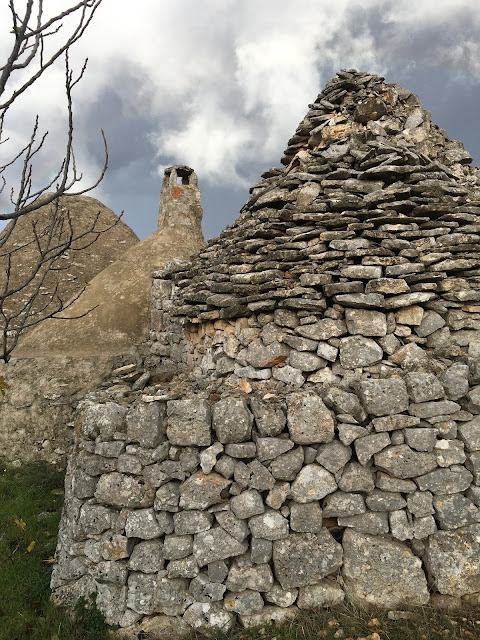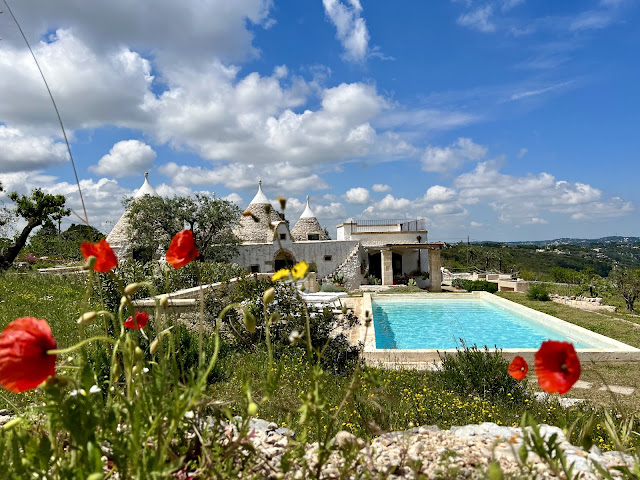Blood on the stone
The day we first clapped eyes on our trullo was one of those enormous, clear, blue sky days when the heat-shimmer on land coupled with the sound of cicadas and distant glimpses of the sea make everything seem possible, even creating a home out of a couple of mounds of collapsed stones.
The first thing I noticed as we parked the cars inside the entrance of the land was an oak tree, well established, upright, shady and somehow symbolic of our adopted home in the UK. I'm one for signs, happily superstitious (despite an absolute intellectual commitment to rationalism and science) and in my 50s ever more trusting of my intuition (okay, in Aussie parlance I trust my gut these days).
The minute I stepped onto that abandoned plot redolent still with the remnants of the hard toil of those that came before us, I was gone. Smitten. Lost.
Human hands had shaped the downhill tumble three centuries before, flattening it into level terraces with steps and clearing it of stones to make room to plant vines, olives and fruit trees. A hole in the hill covered in stones made a water cistern. Nothing was wasted and the rocks placed with such care to create walls and boundaries that they are still there, doing their job despite decades and more of abandon.
The husband, usually the one to hold back his first impressions, was gone too. I could sense it.
We walked, leaped, strode up and down the terraces, looked out to the sea, back toward the road behind us, picked up rocks and put them down again, walked into the dark, damp hobbit caves that were still standing but most of all we began to imagine.
"The kitchen could be here".
"That would make the cosiest bedroom. I can see myself waking up, opening the door and seeing that tree first thing."
"This could be writing heaven...."
The teen let out a shriek after managing to scrape her leg on a dry stone wall that gave way as she jumped off it but rather than whining, declared immediately that as she had left her precious blood on the stones, it was ours now.
Johan and Emelie his daughter, agents and sellers, had glints in their eyes. We tried to curb our over-enthusiasm but failed miserably and I think they knew. Later that evening, we sat on his patio, high above the Selva di Fasano in a trullo he had brought back from ruin to make into his home and office. A few white wines later and the husband was negotiating between being jumped on by their enthusiastic rescue pup, Charlie.
The beauty of this trullo was that plans for its restoration were in place and approvals already granted. The really hard part, negotiating Italian bureaucracy, was pretty much done including the required social and geographical analysis of the local environment (urban, agricultural, coastal), heritage assessments and the structures landscape contexts etc etc.
Ultimately, we knew already that the rules for the renovation of the trulli - square rooms, circular domed roofs - leave very little leeway: they must be brought back to their original size and cannot be changed in any way beyond necessary ventilation and light requirements. The windows for example are traditionally 80 by 80 cm which appear teeny but are in fact environmentally clever as they keep them cool in summer and prevent heat loss in winter while any new building is limited to no more than 20 per cent of the trulli footprint. This means that construction of a new structure (either trullo or lamia - usually rectangular stone rooms with small windows and vaulted rooves - can contain space equivalent to just one fifth of the existing structures.
That night, we drove back home to our rental trullo in silence, my bag full of paperwork and plans - and our heads and hearts full of dreams.
The first thing I noticed as we parked the cars inside the entrance of the land was an oak tree, well established, upright, shady and somehow symbolic of our adopted home in the UK. I'm one for signs, happily superstitious (despite an absolute intellectual commitment to rationalism and science) and in my 50s ever more trusting of my intuition (okay, in Aussie parlance I trust my gut these days).
The minute I stepped onto that abandoned plot redolent still with the remnants of the hard toil of those that came before us, I was gone. Smitten. Lost.
Human hands had shaped the downhill tumble three centuries before, flattening it into level terraces with steps and clearing it of stones to make room to plant vines, olives and fruit trees. A hole in the hill covered in stones made a water cistern. Nothing was wasted and the rocks placed with such care to create walls and boundaries that they are still there, doing their job despite decades and more of abandon.
 |
| This is the water cistern - and will also be restored |
We walked, leaped, strode up and down the terraces, looked out to the sea, back toward the road behind us, picked up rocks and put them down again, walked into the dark, damp hobbit caves that were still standing but most of all we began to imagine.
"The kitchen could be here".
"That would make the cosiest bedroom. I can see myself waking up, opening the door and seeing that tree first thing."
"This could be writing heaven...."
The teen let out a shriek after managing to scrape her leg on a dry stone wall that gave way as she jumped off it but rather than whining, declared immediately that as she had left her precious blood on the stones, it was ours now.
The beauty of this trullo was that plans for its restoration were in place and approvals already granted. The really hard part, negotiating Italian bureaucracy, was pretty much done including the required social and geographical analysis of the local environment (urban, agricultural, coastal), heritage assessments and the structures landscape contexts etc etc.
 |
| Poor old trullo looks surprised and sad |
Ultimately, we knew already that the rules for the renovation of the trulli - square rooms, circular domed roofs - leave very little leeway: they must be brought back to their original size and cannot be changed in any way beyond necessary ventilation and light requirements. The windows for example are traditionally 80 by 80 cm which appear teeny but are in fact environmentally clever as they keep them cool in summer and prevent heat loss in winter while any new building is limited to no more than 20 per cent of the trulli footprint. This means that construction of a new structure (either trullo or lamia - usually rectangular stone rooms with small windows and vaulted rooves - can contain space equivalent to just one fifth of the existing structures.
That night, we drove back home to our rental trullo in silence, my bag full of paperwork and plans - and our heads and hearts full of dreams.
 |
| Me and the sea in the distance |






Comments
Post a Comment